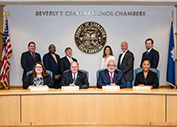
General Info
Charleston County, along with 44 other South Carolina counties, is working with the S.C. Department of Health and Environmental Control (SCDHEC) and the Environmental Protection Agency (EPA) to reduce pollutants that form ground-level ozone. The goal is to meet new federal pollution requirements by the end of 2007.
What Is Ozone?
Ozone is a gas that occurs both in the Earth's upper atmosphere and at ground level. Ozone is one of six criteria pollutants used by the EPA as an indicator of air quality. Depending on where ozone is found, it can be good or bad. Occurring naturally in the upper atmosphere, ozone acts as a shield from the sun's harmful ultraviolet rays.
However, ground-level ozone is a concern during the summer months when the weather conditions are favorable for producing ozone. Ozone is formed by chemical reactions between volatile organic compounds (VOCs) and oxides of nitrogen (NOx) in the presence of sunlight. Ozone is a major ingredient of smog.
Ozone Health Effects
Ozone can cause permanent damage to the respiratory system. Active children are at highest risk from ozone exposure because they often spend a large amount of time outdoors. Active adults of all ages who exercise or work outdoors have an increased risk of exposure to elevated levels of ozone. People with asthma or other respiratory diseases are particularly sensitive to ozone exposure.
Sources Of NOx & VOCs
NOx and VOCs come from emissions from the following sources: stationary, area, mobile and natural. Stationary sources include larger permitted industry and power plants. Area sources are small, stationary and non-transportation sources that collectively contribute to air pollution. Area sources include gas stations (emit NOx) and dry-cleaners (emit VOCs). Mobile sources are divided into two categories, on-road and off-road.
The off-road mobile sources include trains, ships, boats, airplanes, lawn equipment, and construction equipment. On-road mobile sources include cars, trucks, and buses. Natural sources for VOCs are released from vegetation, mostly trees in South Carolina. Natural sources for NOx are very rare and include emissions from soil, lightning, and oceans.
Emission Reduction Strategies
A number of federal control measures are in place and/or will be phased in over the next several years. These programs include new heavy-duty engine and vehicle standards and low sulfur gasoline. There are also federal initiatives currently working to reduce industrial emissions. All of these programs have been developed to help areas attain air quality standards.
The state is also proposing new and/or modifications to regulations that will assist non-attainment areas. The State programs could include a regulation that would result in VOC and NOx reductions; modifications to the open burning regulations and a process to assure transportation plans, programs, and projects consider air quality goals.
Fact Sheet
Ozone Fact Sheet
- Ten to fifteen miles above the earth, stratospheric ozone occurs naturally and protects us from exposure to the sun's ultraviolet radiation. At ground-level, ozone is a result of air pollution and can harm our health. Remember, ozone is good up high, but bad nearby!
- Ground-level ozone is formed when two chemicals, nitrogen oxides (NOx) and volatile organic compounds (VOCs), react in the presence of heat and sunlight.
- NOx and VOCs are emitted when fossil fuels are burned. Some sources of these pollutants are cars, trucks, and industry. Other sources of VOCs include natural sources like pine trees, as well as vapors from paints, glues, and solvents.
- Ground-level ozone is a concern during the hot, summer months.
- Areas that usually have the most severe ground-level ozone problems include densely populated areas and areas with high levels of traffic.
- The Environmental Protection Agency sets standards for ozone and other air pollutants. For each pollutant, there are two standards. The primary standard is set to protect health, regardless of the cost. The secondary standard protects public welfare. Public welfare includes effects on soil, water, property, animals, and visibility.
- When the ground-level ozone level is high, it can cause eye irritation, headaches, dryness of the mouth and throat, shortness of breath, wheezing, and coughing.
- Children, the elderly, and people with pre-existing lung disease such as emphysema, asthma, and chronic bronchitis are especially sensitive to ground-level ozone. However, everyone is sensitive to high levels of ground-level ozone.
- On high ozone days, you can help reduce ozone by combining trips, limiting unnecessary trips, carpooling, avoiding driving during peak hours, and using gas-powered lawn equipment and refueling your car after 6 p.m.
This fact sheet is intended as a summary of issues related to ground-level ozone, and is not all-inclusive. To obtain additional information regarding ozone and the ozone forecast, you may contact the Bureau of Air Quality at (803)898-4123, access the Bureau web page at http://www.scdhec.gov/baq/, or write to the following address:
Bureau of Air Quality
S.C. Department of Health and Environmental Control
2600 Bull Street
Columbia, S.C. 29201
Cleaner Air
You Can Do 25 Things For Cleaner Air
Drive Less: In South Carolina, about half of all man-made air pollution comes from mobile sources like cars, trucks, and off-road vehicles. Fewer trips will reduce air pollution.
- Carpool.
- Walk or ride a bike.
- Shop by phone, mail or the Internet.
- Ride public transit where available.
- Telecommute.
Drive Smart: How you drive your car can help reduce the pollution it creates.
- Accelerate gradually.
- Use cruise control on the highway.
- Combine your errands into one trip, "trip-chain."
- Obey the speed limit.
- Keep your car properly tuned.
- Don't top off your gas tank.
- Replace your car's air filter.
- Keep your tires properly inflated.
- When shopping for your next car, look for the most efficient, lowest polluting model.
Choose Air-Friendly Products: Many products in your home, yard, or office are made of chemicals that escape into the air when you use them. To reduce this type of pollution:
- Select water-based products or those that have low volatile organic compound (VOC) content.
- Use water-based paints or those labeled zero VOC.
- Paint with a brush instead of a sprayer.
- Store solvents like paint thinners in airtight containers.
- Use a reel or electric mower and other non-gas powered equipment, such as edgers.
Save Energy: Saving energy helps reduce air pollution. Power plants burn fossil fuels like coal and oil to produce electricity. When these fossil fuels are burned, pollution is created.
- Turn off the lights when you leave a room.
- Use a fan instead of air conditioning.
- Microwave small meals.
- Properly insulate your home.
- Insulate your water heater.
- Check with your utility company for more energy conservation tips.
This fact sheet is intended as a summary of the modeling requirements, and is not all-inclusive. To obtain additional information regarding air modeling, you may contact the BAQ at (803)898-4123, browse our Internet site at http://www.scdhec.gov/baq/, or write to the following address:
Bureau of Air Quality
S.C. Department of Health and Environmental Control
2600 Bull Street
Columbia, S.C. 29201
Municipalities
City of Charleston
City of Folly Beach
City of North Charleston
City of Isle of Palms
Town of Awendaw
Town of Hollywood
Town of James Island
Town of Kiawah Island
Town of Lincolnville
Town of McClellanville
Town of Meggett
Town of Mount Pleasant
Town of Ravenel
Town of Rockville
Town of Seabrook Island
Town of Sullivan's Island
E-mail your comments or questions about this site to
publicinfo@charlestoncounty.org
Report technical problems with this site to
webmaster@charlestoncounty.org
This is the official web site for Charleston County Government.
Copyright © 2000-2025, Charleston County, South Carolina. All rights reserved.
Legal Disclaimer |
Refund Disclaimer |
Privacy Policy




